In this article, we will share MP Board Class 10th Social Science Book Solutions Chapter 7 The First Freedom Struggle of 1857 Pdf, These solutions are solved subject experts from the latest edition books.
MP Board Class 10th Social Science Solutions Chapter 7 The First Freedom Struggle of 1857
MP Board Class 10th Social Science Text Book Exercise
Objective Type Questions
MP Board Class 10th Social Science Chapter 7 Question 1.
Multiple Choice Questions:
(Choose the correct answer from the following)
Question (a)
Who led the freedom struggle of 1857 in Bundelkhand was:
(a) Kunwar Singh
(b) Bakhtawar Singh
(c) Tatya Tope
(d) Anamadulla Khan.
Answer:
(c) Tatya Tope
Question (b)
The British Governor General of India in 1857 was:
(a) Dalhousie
(b) Willium Bantick
(c) Canning
(d) Rippon.
Answer:
(c) Canning
Class 10 Social Science Chapter 7 MP Board Question 2.
Fill in the blanks:
- After being arrested Bahadur Saha II was sent to ……………………..
- Many Indian states were annexed to the British empire as a result of Dulhosie’s ………………………. policy. (MP Board, 2013)
- An ordinance passed by British Parliament, India was placed under the direct control of ……………………….
- The people of Delhi proclaimed …………………………. as the emperor of India. (MP Board, 2009, 2011)
- British historians depicted Freedom Struggle of 1857 as …………………………
Answer:
- Rangoon
- Doctrine of lapse
- Crown
- Bahadur Shah II
- the sepoy mutiny.
Name The Places Most Affected By Freedom Struggle Of 1857 Question 3.
Match the Column:

Answer:
- (c)
- (d)
- (e)
- (b)
- (a).
MP Board Class 10th Social Science Very Short Answer Type Questions
The First Freedom Struggle Of 1857 Class 10th Question 1.
Name the places most affected.by freedom struggle of 1857?
Answer:
Delhi, Meerut, Barrackpur, Avadh, Rohelkhand, Bundelkhand, Kanpur, Jagdishpur, Lucknow and Gwalior.
MP Board Class 10th Social Science Chapter 7 Solutions Question 2.
Name a few main freedom fighters who led the freedom struggle of 1857? (MP Board 2009)
Answer:
Rani Laxmibai, Kunwar Singh, Begum Hazarat Mahal, Tatyia Tope, Mangal Pandey, Bahadur Shah Zafar.
Name The Place Most Affected By Freedom Struggle Of 1857 Question 3.
What were the immediate causes of freedom struggle?
Answer:
The immediate cause of the Revolt of 1857 was the cartridges incident. The cartridges supplied to the soldiers for the newly introduced enfield rifle were greased with fat and had to be bitten with teeth before being loaded in the rifle. The rumour spread that the cartridges were greased with the fat of cows and pigs. As such many Indian soldiers refused to use them. This sparked the revolt.
MP Board Class 10th Social Science Short Answer Type Questions
Class 10th Social Science Chapter 7 Question 1.
Why is the struggle of 1857 called the first struggle of freedom? (MP Board 2011)
Answer:
The struggle for freedom of 1857 is considered as a glorious and revolutionary event in the history of India. The revolution of 1857 was the first armed revolution which was so widespread and powerful that it shook the foundation of British Empire. By keeping the national problems on center stage, the revolution of 1857 challenged the existence of East India Company’s Rule.
The revolution of 1857 was a nationwide, organized struggle for putting up an end to the British Rule. Although this struggle failed in its mission, its memories and inspiration are still alive in the heart of common man. Among the Indian people an awakening took place followed by the freedom struggle.
Chapter 7 Social Science Class 10 Question 2.
Why did the 1857 uprisings against the British Rule failed?
Answer:
Lack of organised policy, leadership and tradition weapons are the main factors responsible to the failure of 1857 awakening. While the British army and leaders were well planned in there resources and policy. The rising did not spread throughout the country.
It was confined to some pockets of India. Sindh, Kashmir, Rajputana, East Bengal, South India and most of the Punjab did not take part in it. The Sikh, Rajput and Gorkha battallions remained faithful to British and even helped them in suppressing the revolt.
The First Freedom Struggle Of 1857 Class 10th Notes Question 3.
Why were the Indian rulers angry with the British Rule? (MP Board 2010, 2013)
Answer:
The policy of exploitation for the natural and human resources of the country was the matter of dissatisfaction to the Indians. On the other hand, the policy of ‘divide and rule’ proned a dicisive for uprising the Indian against the company rule.
Class 10 Social Science Chapter 7 Question 4.
What changes were introduced in the British administration after the freedom struggle of 1857?
Answer:
The revolt was eventually crushed by British Government but it caused a severe blow to the British Government. Consequentially British Government had to introduce many administrative changes. These changes brought about many transform in Indian society, economy and governance. They were:
1. A declaration was passed in 1858 in British Parliament according to which the right to rule was transferred to British Government from the East India Company.
2. After 1858 there was a restructuring of army. Since British Government had lost faith in Indian soldiers, all important posts in army were given to British officers. More number of European soldiers was inducted. British restructured the Indian army with the policy of “divide and rule”.
3. There was change in policy of merger of states. Adoption of a successor was recognized. Native rules were assured that no more take over of states will take place henceforth.
4. British Government showed a more sympathetic altitude towards landowners, landlords, and native rulers in order to get their support.
MP Board Class 10th Social Science Long Answer Type Questions
Mention The Reason For The Failure Of The First Struggle For Freedom Question 1.
Describe the historical importance of the first struggle for freedom?
Or
Describe the historical importance of the struggle for freedom of 1857? (MP Board 2009)
Answer:
The importance of the first struggle of freedom – 1857 can be discussed under the following heads:
1. The end of the Company Rule in India:
The rule and administrations of East India Company had transferred to British Government. It was then thought that the crown’s administration would bring a new period of good administration.
2. Indian People in Government Service:
It was thought that with the introduction of new government. Indian people will have good chances to secure government services and that would be without any discrimination of colour, creed, sex and other economic grounds.
3. Religious freedom:
In its post policy, it was expected, as per assurance given that religious freedom would be given to the Indian people and Britishers would not interfere in their religious matters.
4. Assurance to the Princely states:
Indian kings were given assurance that their kingdoms would not be annexed. They were also told that right of adoption will also be given.
5. Patriotism:
After the struggle of 1857, the feeling of patriotism was fostered in the minds of the people and they were more confident of achieving things if they are denied by the administration.
Class 10 Social Science MP Board Chapter 7 Question 2.
Write short notes on:
- Tatya Tope
- Rani Laxmibai
- Nana Saheb
- Begam Hazrat Mahal.
Or
“Tatya Tope was a brave freedom fighter”. Write in short? (MP Board 2009)
Or
Write about Rani Laxmibai? (MP Board 2009)
Or
Give a brief introduction of main freedom fighter of first freedom struggle? (MP Board 2009)
Answer:
1. Tatya Tope:
Tatya Tope was one of the valiant soldiers of struggle of 1857 who had their loyalty with Peshwa family. Tatya Tope will be remembered for his patriotism, courage, strategizing skills, military acumen, perseverance in the absence of resources, fearlessness and guerrilla warfare tactics. The entire responsibility of Nana Saheb Peshwa’s military campaign was on the shoulders of Tatya Tope.
Tatya Tope played a major role in acquiring Gwalior for the Queen of Jhansi Laxmibai. After the death of Laxmibai, Tatya Tope continuously engaged himself in guerrilla warfare and challenged British army in Central India and Bundelkhand. He was arrested by British by deceit and betrayal. He was caught in the jungle of Aaron (district Guna) and was hanged in Shivpuri on 18th April, 1859.
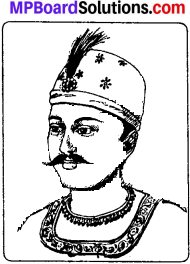
2. Rani Laxmibai:
In the year 1854, following the death of Raja Gangadhar Rao, the husband of Laxmibai, British Government denied their adopted son the throne and merged Jhansi with their empire. Rani Laxmibai protested and fought fiercely. Having defeated by Hurose she landed in Kalapi and, with the help of Tatya Tope she acquired Gwalior.
British commandor Hurose besieged Gwalior fort. On 17th June, 1858 Laxmi sacrificed her life in soldier’s outfit and harnessed with horse. Stories of her valour are still sung and inspire the Indians.
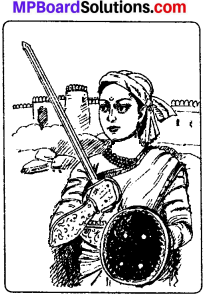
3. Nana Saheb:
Nana Saheb was another important soldier in the freedom struggle. He was the adopted son of Bajirao Peshwa II and stayed in Bithur. After the demise of Bajirao Peshwa, British Govemement refused to grant a title or pension to Nana Saheb. Therefore, Nana Saheb along with his loyal soldiers chased British army off from Kanpur and declared himself a Peshwa. Tatya Tope and Ajimullah were his loyal army chiefs.
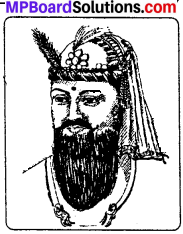
4. Begam Hazrat Mahal:
Begum Hazrat Mahal was the widow of Nawab of Awadh. Once the revolt started, Begum encouraged and manage it. She declared her minor son Birjis Kadar as Nawab of Awadh and ordered her soldiers to attack the British residency in Lucknow. She also led the revolt in Shahajahnpur. After suffering a defeat she went to Nepal.
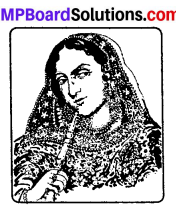
Project Work
The First Freedom Struggle Of 1857 Class 10th MP Board Question 1.
Trace the places related to the freedom on struggle of 1857 on the map of India. Also write the names of regional leaders associated with it?
Answer:
Following are the main places of the freedom struggle of 1857.
- Barrackpur – Revolt by Mangal Pandey, an Indian soldier in British Army.
- Jagdishpur (Ara) – Revolt by Kunwar Singh.
- Ranchi – Revolt by local landlord.
- Faizabad – Revolt led by Maulvi Ahmad Ulla.
- Lucknow – Revolt led by Begum Hazrat Mahal.
- Shahajahnpur – Revolt let by Maulvi Ahmad Shah.
- kanpur – Revolt by Nana Saheb Peshwa.
- Bareilly – Revolt by Barkhat Khan.
- Meerut – Revolt by Indian soldiers of British Army.
- Delhi – Revolt by Mughal Emperor Bahadur Shah Zafar.
- Jhansi – Revolt under the leadership of Maha rani Laxmibai and Tatya Tope.
- Gwalior – Maharani Laxmibai and Tantiya Tope went to Gwalior to seek help of Sindhia. When Sindhia refused, they captured Gwalior, which was later on recaptured by Sindhia with the help of the British.
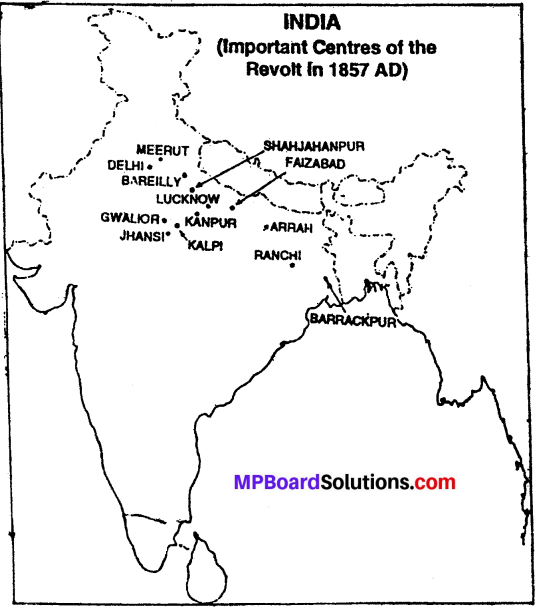
Chapter 7 Class 10 Social Science Question 2.
Analyse, what do you think were the causes of failure of freedom struggle of 1857. Share your view’s with your classmates?
Answer:
Do yourself with the help of your classmates.
MP Board Class 10th Social Science Additional Important Questions
Objective Type Questions
MP Board Class 10 Social Science Chapter 7 Question 1.
Multiple Choice Questions:
(Choose the correct answer from the following)
Question (a)
Kunwar Singh was the landlord of:
(a) Bihar
(b) Jagdishpur
(c) U.P.
(d) Meerut.
Answer:
(b) Jagdishpur
Question (b)
The revolt out breaked at Meerut on:
(a) 10 April 1857
(b) Jagdishpur
(c) 10 June 1857
(d) 10 July 1857.
Answer:
(b) Jagdishpur
Question (c)
The Commander of Mughal army Bakht Khan led the revolt in:
(a) Jhansi
(b) Lucknow
(c) Delhi
(d) Kanpur.
Answer:
(c) Delhi
Question (d)
Bahadurshah was sent to Rangoon in:
(a) 1860
(b) 1861
(c) 1862
(d) 1864.
Answer:
(c) 1862
Mention The Reason Of The Failure Of The First Struggle For Freedom Question 2.
Fill in the blanks:
- …………………….. called the revolt of 1857 as the first struggle for freedom.
- Barrackpur is situated in the state of …………………….
- The disputed cartridge was made of the fat of ……………………….
- ………………………… was the founder of Subsidiary Alliance.
- Residence of Nana Sahib was in ………………………….. (MP Board 2009)
Answer:
- Damodar Savarkar
- Bengal
- cow and pig
- Lord Wellesely
- Bithur.
Social Science Class 10 Chapter 7 Question 3.
True and False type questions.
- Lord Dalhousie was the founder of doctrine of lapse.
- The battle of Plassy was started in 1857.
- Mangal Pandey was the soldier of 34th batallion.
- The British East India Company was established in the year of 1700.
- Bahadur Shah II was declared the king of India by public of Delhi. (MP Board 2009)
- The British Governer General of India during the struggle of 1857 was Lord Dalhousie. (MP Board 2009)
Answer:
- True
- False
- True
- False
- False
- False.
Question 4.
Match the column:
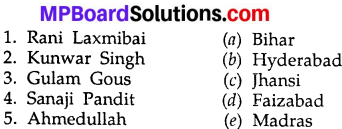
Answer:
- (c)
- (a)
- (e)
- (b)
- (d)
Answer in One – Two Words or One Sentence
Question 1.
How much people sacrificed their lives in this struggle?
Answer:
Lakhs of people sacrified their lives in this struggle.
Question 2.
When was British East India Company established?
Answer:
In the year 1600.
Question 3.
When did Aurangzeb die?
Answer:
In 1707.
Question 4.
What was the name of British Company?
Answer:
British East India Company.
Question 5.
When did the battle of Plassy started?
Answer:
1757.
Question 6.
When was Mangal Pandy executed?
Answer:
Mangal Pandey was executed on 8 April, 1857.
Question 7.
Who declared Bahadur Shah – II as the emperor of India?
Answer:
The soldiers declared Bahadur Shah – II as the emperor of India.
Question 8.
Who led the revolt in Bihar?
Answer:
Kunwar Singh.
Question 9.
Who led the army of Nana Saheb?
Answer:
Tatya Tope.
Question 10.
To whom Begum Hazrat Mahal declared as the Nawab of Awadh?
Answer:
Her younger son Birjis Kadar.
MP Board Class 10th Social Science Very Short Answer Type Questions
Question 1.
Mantion the important centres of the Revolt of 1857?
Answer:
Delhi, Meerut, Kanpur, Lucknow, Jhansi, Barrackpur, Allahabad, Arraha, Gwalior and Bareilly.
Question 2.
Why the British Government discourged the cottage industries of handlooms and handicrafts?
Answer:
In order to sell more and more finished goods manufactured in England, the British Government discourged the cottage industries of handlooms and handicrafts.
Question 3.
What was the statement of Major Edwarden?
Answer:
Major Edwarden’s statement was the ultimate aim of the British rule to make India a Christian country.
Question 4.
Who was Mangal Pandey?
Answer:
Mangal Pandey was a soldier and on 29 March, 1857 he refused to use the larded cartridge and shot a British officer in a feat of anger.
Question 5.
Who was Bahadurshah Jafar II?
Answer:
Bahadur Shah Zafar II was the last Mughal emperor of India. Despite his old age, Bahadurshah II accepted the leadership of revolt. Looking to the enthusiasm of soldiers, he was also optimistic about the success of revolt.
MP Board Class 10th Social Science Short Answer Type Questions
Question 1.
What do you mean by the East India Company?
Answer:
The British East India, Company was established in the year 1600. To earn more and more profit through trade was the main aim of the company. In order to achieve its objective, the company did not hesitate to even use the unscrupulous methods.
Surat was the first place to be developed as a trade center by East India Company. Following which the company established its main trade centers in Bharuch, Ahmedabad, Agra, Macchlipatnam, Madras, Calcutta, Bengal and Mumbai etc.
By the end of 17th century, the East India Company began, aspiring for the political foot hold in India so that it would facilitate its commercial activities. After Aurangzeb’s death in 1707, Mughal empire started disbanding. The whole nation disintegrated into smaller states. Many of the states became virtually independent. These circumstances led to establishing company’s foothold in the country.
Question 2.
What is the importance of Meerut in 1857?
Answer:
The Barrackpur incident was repeated in Meerut too. About 85 soldiers of Indian cavalary refused to use larded cartridges. As a result they were dismissed from the army and were imprisoned, as a reaction to their dismissal, the other soldiers in Meerut, on 10th May 1857, openly confronted the Government by breaking in to the prison and liberating the arrested soldiers. They then marched towards Delhi and took control of armory. The soldiers declared Bahadur Shah – H as the emperor of India, who wrote letters to various rulers of India seeking their support.
Question 3.
Why were the Indian rulers angry with the British rule? (MP Board 2010, 2013)
Answer:
Due to British territorial extension policies there was a lot of dispute among land – lords and Jamindars. Lord Wellesley introduced the scheme to bring the India rulers under the British thumb with the plan of Subsidiary Alliance. The Doctrine of Lapse policy of dissolution of state, Lord Dalhousie caused many Indian states to be a part of the British empire.
British took control of many states like Punjab, Sikkim Satara, Jhansi, Nagpur etc. British were disrespectful towards the last Mughal emperors which caused a state of anxiety among ruling families, and British seiged lands from many jamindars and sardars which resulted in unempbyment of many people working there previously.
Question 4.
Which classes of Indians joined the Revolt of 1857 to show their resentment against the British rule?
Answer:
Following were the main classes:
- The peasants whose land were taken away and auctioned.
- The artisans who became unemployed due to loss of partronage.
- The common people who feared forcible conversion to Christianity.
- The soldiers who were refused promotion and equality of pay and status.
- The princely rulers whose states had been annexed under the Doctrine of Lapse, Subsidiary Alliance and through direct annexation.
Question 5.
What were the main results of the 1857 revolt?
Or
Mention two consequences of the Revolt of 1857?
Answer:
The main results or consequneces of the revolt of 1857 were:
- The company’s rule came to an end and India was placed under the direct control of British Government.
- The British Government declared that no more territories would be annexed to the British Empire.
- The Indian rulers were allowed to adopt sons. It was also declared that the treaties entered into with the company shall be honoured.
- Religious freedom was guaranteed to the Indian people.
- The revolt brought the Hindu-Muslim unity.
Question 6.
What led to the failure of freedom struggle of 1857? (MP Board 2010, 2011)
Or
Write any four reasons of failure of the first freedom struggle? (MP Board 2009)
Answer:
The reasons of failures of the freedom struggle:
The revolt of 1857 did not bring about positive outcome but it proved to be a milestone in gaining the freedom. This revolt did not receive success in full measure because of the following:
1. Lack of unity and organization:
The chief cause of failure of first war of freedom was lack of unity and organized effort. Neither was a proper planning for the revolt nor any concrete programme. This resulted in unorganized and limited attempt.
2. Lack of leadership:
One of the main reasons of failure was, a lack of powerful leadership which was capable of strategizing. Due to the lack of a single capable leadership, this revolt did not succeed in its objective.
3. Traditional and outdated weapons:
Indian soldiers had to use traditional weapons like sword, bow and arrow, spear, barchha unlike the British soldiers who had modern and sophisticated weapons with a big artillery.
4. Unawareness of Bahadurshah II.
5. Lack of communication.
6. Localise revolt.
7. No common language of communication.
MP Board Class 10th Social Science Long Short Answer Type Questions
Question 1.
The Freedom Struggle of 1857 was a mass struggle? Explain?
Answer:
A large number of people participated in the struggle. On one hand the soldiers were revolting against the British regime, on the other hand common people were protesting against on roads with spears, axe and sticks in hands. The fear of administration and rulers was eliminated from people of villages.
Wherever the soldiers could not reach, these villagers organized themselves and came forward to protest and revolt. Farmers, artisans and landlords whose lands were seized came forward openly to express their agitation. Every policy that affected Indian society adversely affected the soldiers as well, therefore the similarity in the interests of soldiers and common man was a major issue of unity.
This blurred the line of divide between caste and religion. Hindus and Muslims became closer more than before. This struggle of freedom always inspired the coming generations of India. The struggle of 1857 implanted the nationalistic feelings. This caused to reinforce a cultural unity in the country.
The main feature of this revolt was that Indians realised the importance of unity and organization for the achievement of their goals. Therefore, common goal, religious harmony and feeling of co-operation between people makes the struggle for freedom of 1857 an event of national importance.
Question 2.
Describe the political reasons of the revolt of 1857? (MP Board 2009)
Answer:
There was a lot of discontent among landlords and jamindars due to the British territorial extension policies. Lord Wellesely’s introduced a scheme to bring the India rulers under the British thumb. He named this plan the Subsidary Alliance.
The Doctrine of Lapse policy of dissolution of states, Lord Dulhosie caused many Indian states to be dissolve in British empire. British took control of many states like Punjab, Sikkim, Satara, Jaitpur, Sambhalpur, Jhansi Nagpur etc. The British Govt, ended state titles conferred to Nawab’s of Awadh, Tanjore and Karnataka which caused a political distability therein. British were disrespectful towards the last Mughal emperors.
This caused a state of anxiety among ruling families, whichever states’ British took control of, their soldiers, craftsmen and people connected with various other trades were adversely affected. British seized lands from many Jamindars and Sardars which resulted in unemployement of many people working there previously.
Question 3.
What was the education policy suggested by Lord Macaulay? How Indian languages, culture and traditions was affected through this policy?
Answer:
The education policy formulated by Lord Macaulay was an attack on Indian culture and education system. Lord Macaulay was prejudiced and was against education in vernacular languages. Macaulay considered English as a superior race and English language as finest language.
He therefore encouraged English language and western and scientific learning, but at that point of time, Lord Macaulay’s aim was to protect the interests of British rule in India by providing English education and prepare a class of people who would help in running of British administration.
Macaulay was such a conceited racist that he recommended a ban on printing and translation of books in oriental languages. The followers of oriental education considered, English education policy as an attack on their culture, traditions and language and protested against it.
Question 4.
Describe the main causes of freedon struggle of 1857. (MP Board 2009)
Answer:
The main causes of freedom struggle of 1857 were:
1. The Political Causes:
The British policy of annexation derived many native rulers of their states. Lord Delhousie’s Doctrine of Lapse resulted in the annexation of many states. He annexed Outh on the pretext of bad government. All this led to widespread discontent.
2. Economic Causes:
Economic policies of the British Government disrupted .the traditional social and economic relationships. Peasants were dispossessed of their lands; native industries and trade was ruined, the artisans were rendered jobless. The new revenue system led to peasant indebtedness.
3. Raligious Causes:
The British Government paid little attention to the religious beliefs and sentiments of the Indian people. Indians began to feel that the British Government wanted to forcibly convert them, to Christianity.
4. Social Causes:
Racial discrimination, prohibition of sati practice, legalising widow – remarrige, banning infanticide, etc. were regarded as an interference in the Indian’s social matters.
5. Military Causes:
There was widespread discontent in the army. Indian soldiers were paid low salaries as compared with the British soldiers of the same rank. Doors of promotion were closed on them. They could not rise above the rank of a Subedar. British officers maltreated them.
Question 5.
Why were the Indian unhappy with social reforms introduced by the British Government? (MP Board, 2011, 2013)
Answer:
The social and religious policies of company caused a lot of discontent among Indians. Indians developed an apprehension that British Government was bent upon destroying their religion and traditions. Major Edwarden’s statement was “the ultimate aim of the British rule was to make India a Christian country”.
Company Government made many laws and took major steps to eradicate the social evils prevailing in India. Indians considered this as an interference in their social life. The Christian missionaries tried to convert the Indian people to Christianity. They made objectionable and violent public attacks on Hinduism and Islam. The rumours that the British Government was forcibly converting Indians into Christianity.
The Indian sepoys who had by their dedicated service enabled the British Company to conquer India were a dissatisfied lot. They were not only ill – treated by their seniors but were paid very less salary. They were treated with contempt by their British officers.
The growing poverty of the Indian people made them revolt against the mighty British kingdom. The poverty had emanated out of the faulty economic policy followed by the Britishers in India. Their economic policy led to the impoverishment of the peasantry, artisans, handicraftsmen and a large number of tradition zamindars.
A large number of peasant proprietors became landless and fell into the clutches of money lenders. Excessive land revenue, prevalence of corruption at the lower level of administration and lack of interest in the improvement of agriculture etc. made people revolt against the British Government. These all causes were working as the catalyte to uprise the revolt on the social base.